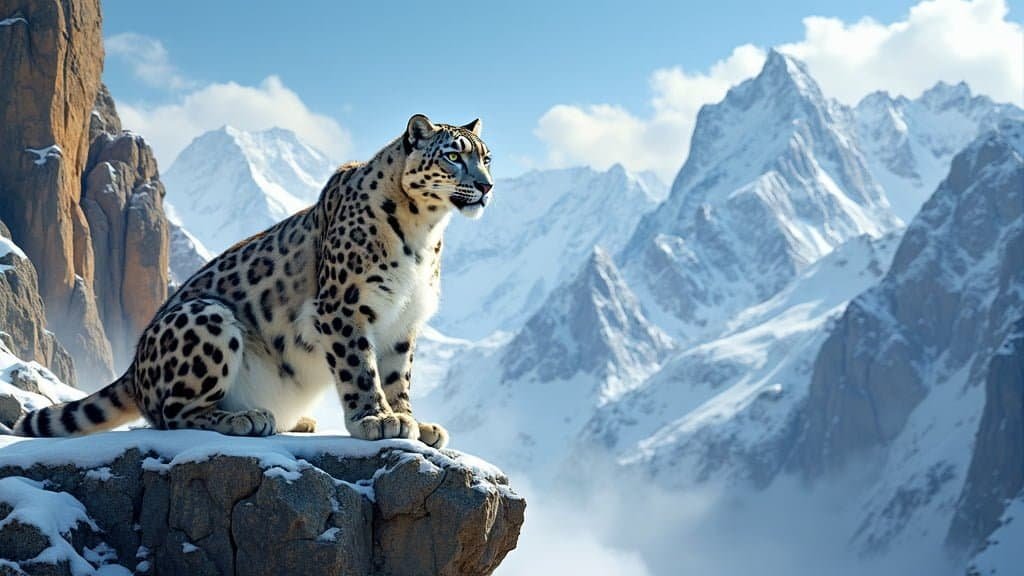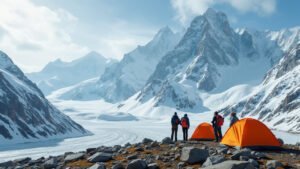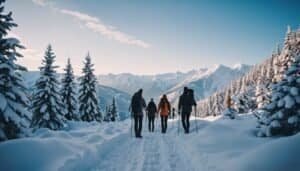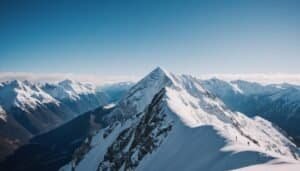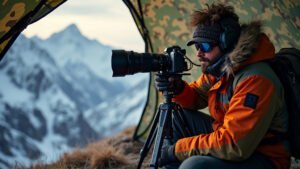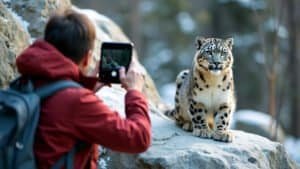Introduction
Snow leopards are among the most elusive and majestic big cats on the planet. Sightings of these incredible animals are rare, but certain regions have become known as hotspots for those hoping to catch a glimpse of them in the wild
In this article, we’ll explore the top destinations worldwide for snow leopard sightings, highlight the best times to visit, and provide practical travel tips. Whether you’re planning a guided tour or an independent expedition, understanding the local conditions and conservation efforts is key to a successful and responsible wildlife experience
Top Countries for Snow Leopard Sightings
Snow leopards inhabit some of the most remote and rugged landscapes on Earth, primarily in Central and South Asia. Spotting one of these elusive cats in the wild is a rare and thrilling experience
However, certain countries have emerged as prime destinations for snow leopard sightings due to their robust populations and the increasing efforts to promote wildlife tourism. Here’s a closer look at the top countries where your chances of seeing a snow leopard are highest
Best Spots in India
India is home to a significant population of snow leopards, especially in the northern regions. The Hemis National Park in Ladakh is one of the most renowned places for snow leopard sightings
This park, often dubbed the “Snow Leopard Capital of the World,” offers a high chance of spotting these big cats, particularly in winter when they descend to lower altitudes in search of prey. The best time to visit is between January and March, when snowfall drives the leopards into more accessible areas. Another notable region is Spiti Valley in Himachal Pradesh, which also offers good opportunities for sightings
India’s conservation efforts, such as the Snow Leopard Project and Project Snow Leopard, have helped stabilize and even increase the snow leopard population in these regions
The Indian government, in collaboration with various NGOs, conducts regular surveys and uses camera traps to monitor snow leopard numbers, ensuring the continued survival of this species in the wild
Where to See Snow Leopards in Mongolia
Mongolia is another top destination for snow leopard enthusiasts. The country is home to around 1,000 snow leopards, the second-largest population in the world. The rugged Altai Mountains, stretching across western Mongolia, provide an ideal habitat for these solitary cats
The Tavan Bogd National Park, located in the Altai Mountains, is one of the most promising locations for sightings. Visitors to this park often embark on guided tours with local trackers who are familiar with the snow leopards’ habits and territories, significantly increasing the chances of a sighting
The Mongolian government, in partnership with organizations like the Snow Leopard Trust, has implemented community-based conservation programs to protect snow leopards while supporting local livelihoods
These initiatives include training local herders as eco-guides, which not only helps in conservation efforts but also provides alternative income sources for communities
Popular Locations in Kyrgyzstan and Tajikistan
Kyrgyzstan and Tajikistan, located in the heart of Central Asia, offer some of the most remote and breathtaking landscapes for snow leopard sightings. The Pamir and Tien Shan mountain ranges, spanning both countries, are key habitats for these elusive cats
In Kyrgyzstan, the Sarychat-Ertash State Nature Reserve is a notable hotspot, where snow leopards are regularly spotted. This reserve is part of a larger network of protected areas that are crucial for snow leopard conservation
Tajikistan’s Zorkul Nature Reserve, located in the Pamir Mountains, is another prime location. Here, snow leopards are often seen in the alpine meadows and rocky outcrops, particularly during the winter months
The Pamir Mountains’ harsh and rugged terrain makes it a challenging yet rewarding destination for wildlife enthusiasts. Both Kyrgyzstan and Tajikistan have seen an increase in wildlife tourism, with several tour operators now offering specialized snow leopard tracking expeditions
These countries—India, Mongolia, Kyrgyzstan, and Tajikistan—offer some of the best opportunities in the world to see snow leopards in their natural habitat. However, it’s important to remember that snow leopard sightings are never guaranteed due to their elusive nature
Patience, careful planning, and choosing the right season are key to increasing your chances of success. Additionally, supporting conservation-friendly tourism helps ensure that these magnificent creatures continue to roam the mountains for generations to come
Best Times of Year to See Snow Leopards
When planning a trip to spot snow leopards in the wild, timing is everything. These elusive cats are most visible during specific seasons, which vary depending on the region. Understanding the best times of year to visit can significantly improve your chances of witnessing a snow leopard in its natural habitat
Seasonal Patterns in Snow Leopard Sightings
Snow leopards are most active in their search for food during the colder months, which is why winter is generally considered the best time for sightings
As temperatures drop and snow covers the higher altitudes, snow leopards move to lower elevations in search of prey like ibex and blue sheep. This migration makes them easier to spot, as they often traverse through valleys and other areas accessible to wildlife enthusiasts
In many regions, the snow leopard’s prey also becomes more concentrated in certain areas during winter, further increasing the likelihood of encounters
For instance, in Ladakh, India, the snow leopards follow the blue sheep herds down to the valleys, offering a unique opportunity for wildlife watchers and photographers to observe these big cats in action
Winter vs. Summer Sightings
While winter is the prime season for snow leopard sightings, summer can still offer opportunities, particularly for those interested in exploring the leopards’ high-altitude habitats
During the summer months, snow leopards retreat to higher elevations, making them harder to spot but not impossible. This is particularly true in regions like Mongolia’s Altai Mountains, where some tour operators specialize in high-altitude summer treks that follow the snow leopard’s path. However, summer sightings require more challenging treks and a deeper understanding of the terrain
In contrast, winter tours are often less physically demanding and offer a higher probability of sightings. The snow cover in winter also makes tracking snow leopards easier, as their footprints and trails become more visible against the white landscape
Tour operators in regions like the Indian Himalayas and Kyrgyzstan typically schedule their snow leopard expeditions during the colder months to maximize the chances of a successful sighting
Optimal Months for Spotting Snow Leopards
The best months for snow leopard sightings vary slightly depending on the region but generally fall between late December and early March
In India, the peak season is from January to February, when snowfall is heaviest, and snow leopards are most likely to descend to lower altitudes. Similarly, in Mongolia, February and March are ideal months for sightings in the Altai Mountains
Kyrgyzstan and Tajikistan also see a peak in sightings from January through March, especially in protected areas like the Sarychat-Ertash Reserve and the Pamir Mountains
These months are characterized by colder temperatures and frequent snowfall, which drive snow leopards to more accessible areas, increasing the likelihood of sightings
While these are the optimal months, it’s essential to be prepared for harsh winter conditions. Temperatures can plummet to well below freezing, and snowstorms are common, so adequate gear and preparation are crucial for a safe and successful expedition
Timing your trip to coincide with the optimal snow leopard sighting season can make all the difference in your wildlife experience. While winter months offer the best opportunities to see these elusive big cats, summer treks can also be rewarding for the more adventurous traveler
Regardless of the season, careful planning and choosing the right time to visit are key to enhancing your chances of encountering a snow leopard in its natural habitat
Guided Tours and Wildlife Expeditions
Embarking on a guided tour or wildlife expedition is one of the most effective ways to increase your chances of spotting snow leopards in the wild
These tours are led by experienced guides who are familiar with the local terrain and the behavior of snow leopards, making them invaluable resources for travelers. Here’s what you need to know about choosing the right tour, staying safe, and supporting ethical wildlife tourism
Choosing the Right Snow Leopard Tour
When selecting a snow leopard tour, it’s essential to consider factors such as the experience of the guides, the tour’s focus on wildlife conservation, and the group size
Experienced guides are key to a successful tour—they understand the snow leopard’s behavior, tracks, and preferred habitats, greatly enhancing the likelihood of a sighting. Additionally, small group sizes allow for a more personalized experience and reduce the impact on the environment
Some of the most reputable tour operators in regions like Ladakh, India, and Mongolia offer specialized snow leopard tracking tours that include not just the opportunity to see these elusive cats but also to learn about their conservation
Operators such as Snow Leopard Adventures and Nomadic Expeditions in Mongolia, for instance, are known for their ethical approach to wildlife tourism, ensuring that the tours support local communities and conservation efforts. Many of these tours also contribute a portion of their proceeds to snow leopard conservation programs
It’s also worth considering the physical demands of the tour. Snow leopard habitats are often in remote and rugged areas, requiring long hikes at high altitudes
Some tours are designed for more adventurous travelers, involving camping and trekking through challenging terrain, while others offer more comfortable accommodations and less strenuous activities
Safety and Ethical Considerations
Safety is a paramount concern when venturing into snow leopard habitats, which are often located in harsh, high-altitude environments. It’s important to be well-prepared with the right clothing, gear, and physical conditioning
Hypothermia and altitude sickness are real risks in these regions, so selecting a tour that provides adequate support and acclimatization time is crucial
Ethical considerations are also important when choosing a snow leopard tour. Responsible wildlife tourism should prioritize the well-being of the animals and their habitat. This means choosing tours that do not disturb the snow leopards or their prey, and that support local conservation efforts
Avoiding tours that engage in practices like baiting or other unethical methods to attract snow leopards is critical. Instead, opt for operators that adhere to strict guidelines for wildlife viewing, ensuring that the natural behavior of the snow leopards is not disrupted
Moreover, the best tours often incorporate educational components, teaching participants about the ecology of the snow leopards and the importance of conservation. This not only enriches the experience but also fosters a deeper appreciation for the need to protect these majestic animals and their habitats
Recommended Tour Operators
Several tour operators have earned a reputation for offering high-quality, ethical snow leopard expeditions
In India, Wildlife Trails offers expertly guided tours in Hemis National Park, combining snow leopard tracking with cultural experiences in the local Ladakhi communities. Their guides are well-versed in the behavior of snow leopards and work closely with local conservationists to ensure a minimal impact on the environment
In Mongolia, Nomadic Expeditions is a leader in eco-friendly tourism, offering snow leopard tracking tours in the Altai Mountains. They collaborate with the Snow Leopard Trust, an organization dedicated to the conservation of snow leopards, ensuring that their tours contribute directly to the protection of this species
Another notable operator is Naturetrek, which offers snow leopard expeditions in India and Central Asia, known for their experienced guides and commitment to sustainable tourism
These operators also emphasize the importance of respecting local cultures and involving communities in tourism activities. By employing local guides and supporting community-based conservation projects, they help ensure that the benefits of wildlife tourism are shared with the people who live alongside snow leopards
Guided tours and wildlife expeditions offer an excellent opportunity to see snow leopards in their natural environment while supporting conservation efforts. By choosing reputable operators, prioritizing safety, and adhering to ethical wildlife viewing practices, travelers can enjoy a rewarding and responsible wildlife experience
These tours not only increase the chances of a snow leopard sighting but also contribute to the long-term protection of these magnificent animals and their habitats
Accessibility and Travel Tips
Visiting snow leopard habitats often involves traveling to some of the most remote and challenging regions in the world. Proper planning and preparation are essential to make the journey as smooth as possible and to maximize your chances of seeing these elusive cats
Here’s what you need to know about getting to snow leopard habitats, choosing accommodations, and preparing for the journey
Getting to Snow Leopard Habitats
Reaching snow leopard habitats usually requires traveling to remote areas that are not easily accessible. The journey often involves multiple modes of transportation, including long drives, flights, and sometimes even treks
For instance, to reach Hemis National Park in Ladakh, India, travelers typically fly into Leh, the region’s main town, and then drive several hours to the park. The road to Hemis can be challenging, particularly in winter, with snow and ice making travel difficult. It’s important to allow for extra travel time and to be flexible with your itinerary in case of weather-related delays
In Mongolia, snow leopard habitats in the Altai Mountains are similarly remote. Visitors usually fly into Ulaanbaatar, the capital, and then take a domestic flight to Ulgii, followed by a long drive to the base of the mountains
The roads in these areas can be rough and unpaved, requiring a 4×4 vehicle. Tour operators often arrange all transportation, but it’s essential to confirm these details in advance
In Kyrgyzstan and Tajikistan, accessing snow leopard regions like the Pamir and Tien Shan mountains involves travel to remote villages followed by treks into the mountains
For example, getting to the Sarychat-Ertash Reserve in Kyrgyzstan may require a combination of driving and hiking, depending on the weather and road conditions. In these regions, high-altitude acclimatization is crucial, as the elevation can exceed 14,000 feet
Accommodation Options Near Sightings
Accommodation near snow leopard habitats ranges from basic guesthouses to more comfortable lodges, depending on the region
In Hemis National Park, travelers can stay in traditional Ladakhi homestays, which offer a unique cultural experience and direct support to the local community. These homestays are often simple, with limited amenities, but they provide warm hospitality and a chance to immerse yourself in the local way of life
For those seeking more comfort, there are a few eco-lodges and guesthouses near the park that offer better facilities, including heating, hot water, and private bathrooms. However, it’s important to manage expectations, as even the best accommodations in these remote areas are basic compared to urban standards
In Mongolia, accommodation options in the Altai Mountains are similarly limited. Most snow leopard expeditions involve staying in traditional gers (yurts), which are portable, round tents used by nomadic herders
These gers provide a unique and authentic experience, but they also offer minimal comfort, with no running water or electricity. Some tour operators may offer upgraded gers with additional amenities, such as wood-burning stoves for heating, but these are still relatively rustic
In Kyrgyzstan and Tajikistan, accommodations are typically in simple guesthouses or homestays, often run by local families
These lodgings offer a chance to experience the hospitality of Central Asian cultures, but they are generally basic, with shared bathrooms and limited heating. In some cases, especially on multi-day treks, travelers may need to camp, so bringing appropriate camping gear is essential
Essential Gear and Preparation
Traveling to snow leopard habitats requires thorough preparation, especially in terms of gear and clothing
The high-altitude, cold environments demand warm, layered clothing, including thermal underlayers, insulated jackets, and waterproof outerwear. Proper footwear is also crucial, with sturdy, insulated boots recommended for trekking through snow and rough terrain
Given the remote nature of these regions, it’s important to bring essential gear that might not be readily available on site. This includes high-quality binoculars for spotting snow leopards from a distance, a camera with a good zoom lens for photography, and a daypack for carrying supplies during treks
A first-aid kit, high-calorie snacks, and a water purification system are also recommended, as medical facilities and clean drinking water may not be available
Acclimatization to high altitudes is another critical consideration. Snow leopard habitats often sit at elevations above 10,000 feet, where the risk of altitude sickness is significant. It’s advisable to spend a few days at intermediate altitudes to allow your body to adjust before venturing higher. Tour operators typically build acclimatization days into their itineraries, but it’s wise to discuss this with them beforehand to ensure your safety
Travel insurance that covers high-altitude trekking and emergency evacuation is highly recommended. Given the remote locations and challenging conditions, being prepared for the unexpected is essential
Accessing snow leopard habitats requires careful planning and preparation, from choosing the right transportation and accommodations to packing essential gear. While the journey can be challenging, the reward of seeing a snow leopard in the wild is well worth the effort
By preparing adequately and selecting the right tour, you can ensure a safer, more enjoyable, and ultimately successful expedition into the mountains where these magnificent creatures roam
Conservation and Responsible Tourism
Conservation efforts are crucial to the survival of snow leopards, whose populations are threatened by habitat loss, poaching, and climate change
Responsible tourism plays a significant role in supporting these efforts by raising awareness, providing funding, and involving local communities in conservation activities. Here’s a look at the key conservation programs in place and how travelers can contribute to the protection of snow leopards
Snow Leopard Conservation Programs
Several organizations are dedicated to the conservation of snow leopards across their range in Central and South Asia. The Snow Leopard Trust, one of the most prominent organizations, works in five key countries—India, Mongolia, China, Kyrgyzstan, and Pakistan—where over 75% of the world’s snow leopard population resides
The Trust focuses on research, community-based conservation, and policy advocacy. Their research includes the use of camera traps and GPS collars to track snow leopards, which provides invaluable data on their movements, population size, and threats
In India, Project Snow Leopard, launched by the government in 2009, aims to promote the conservation of the snow leopard and its habitat by involving local communities
This project works in key snow leopard habitats, including the states of Jammu & Kashmir, Himachal Pradesh, and Uttarakhand, and focuses on reducing human-wildlife conflict, securing prey populations, and enhancing community livelihoods through eco-tourism
In Kyrgyzstan, the Global Snow Leopard and Ecosystem Protection Program (GSLEP) is an initiative launched in 2013 by 12 snow leopard range countries, with the goal of protecting and conserving snow leopards and their ecosystems
The GSLEP supports a range of activities, from anti-poaching patrols to habitat restoration, and encourages collaboration between governments, NGOs, and local communities
These conservation programs are critical not only for protecting snow leopards but also for preserving the entire ecosystems in which they live. Snow leopards are apex predators, and their presence is indicative of a healthy environment. By conserving snow leopards, we also protect countless other species that share their habitat
How Tourism Supports Conservation
Tourism can be a powerful tool for conservation when done responsibly. Revenue generated from wildlife tourism often funds conservation initiatives directly, providing the financial resources needed to maintain protected areas, conduct research, and implement anti-poaching measures
In regions like Ladakh, India, tourism related to snow leopards has become a significant source of income, helping to fund local conservation projects and support the livelihoods of local communities
Community-based tourism, where local people are involved in guiding, homestay operations, and cultural experiences, not only provides income but also creates a vested interest in the preservation of snow leopards and their habitats
For example, in Mongolia, the Snow Leopard Enterprises program, run by the Snow Leopard Trust, allows local herders to produce and sell handicrafts, with a portion of the profits going directly to snow leopard conservation efforts. This initiative reduces the economic pressure on herders to poach snow leopards or their prey
Moreover, responsible tourism helps to raise awareness about the challenges facing snow leopards. Tourists who learn about conservation issues are often inspired to contribute to the cause, whether through donations, advocacy, or simply spreading the word. This broader awareness is crucial for building global support for snow leopard conservation
Tips for Responsible Wildlife Watching
If you’re planning a trip to see snow leopards in the wild, it’s important to do so in a way that minimizes your impact on the environment and the animals. Here are some tips for responsible wildlife watching:
Choose Ethical Tour Operators: Select tour companies that prioritize conservation and operate in an environmentally responsible manner. Ensure that the tour operator follows ethical guidelines for wildlife viewing, such as maintaining a safe distance from animals and not using bait to attract them
Respect Local Cultures and Traditions: Engage with local communities in a respectful and culturally sensitive manner. Supporting local businesses and participating in community-led tourism initiatives can have a positive impact on conservation efforts
Minimize Your Environmental Footprint: Travel lightly by minimizing waste, using eco-friendly products, and adhering to Leave No Trace principles. Avoid disturbing wildlife, and be mindful of your behavior in sensitive habitats
Support Conservation Efforts: Consider donating to reputable conservation organizations or participating in citizen science programs that contribute to snow leopard research. Every contribution, no matter how small, helps to protect these magnificent animals
Educate Yourself and Others: Learn about the challenges facing snow leopards and share that knowledge with others. The more people who understand the importance of snow leopard conservation, the greater the collective effort to protect them
Conservation and responsible tourism are essential to ensuring the survival of snow leopards in the wild. By supporting ethical tourism practices, contributing to conservation programs, and raising awareness about the importance of protecting these animals, travelers can play a crucial role in safeguarding snow leopards for future generations
Every responsible action taken by visitors to snow leopard habitats helps to ensure that these “ghosts of the mountains” continue to thrive in their natural environments
Conclusion
Snow leopards are among the most elusive and majestic creatures in the world, drawing wildlife enthusiasts to some of the most remote and challenging regions on Earth
From the snow-covered peaks of the Himalayas to the rugged mountains of Central Asia, these destinations offer incredible opportunities to witness snow leopards in their natural habitat. The best chances of spotting these big cats occur during the winter months, when they descend to lower altitudes in search of prey, and guided tours led by experienced trackers greatly enhance the likelihood of a successful sighting
However, seeing a snow leopard is only part of the experience. The journey involves navigating difficult terrain, staying in simple accommodations, and preparing for the physical demands of high-altitude travel
Despite these challenges, the reward is not just in the sighting but also in contributing to the ongoing conservation of this endangered species. Responsible tourism plays a crucial role in supporting conservation efforts, helping to fund initiatives that protect snow leopards and preserve the ecosystems they inhabit
By planning your trip carefully, choosing ethical tour operators, and respecting both the wildlife and the local communities, you can ensure that your adventure not only fulfills a lifelong dream of seeing a snow leopard but also helps to protect these incredible animals for generations to come
